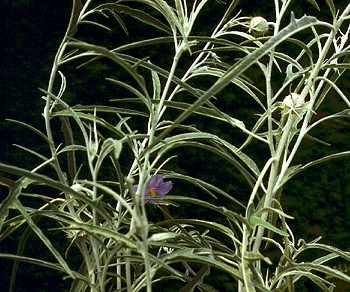
Synonymy
Solanum tudununggae Symon, J. Adelaide Bot. Gard. 4: 307, figs 136, 144, 145 (1981)
T: Kalumburu Mission, North Kimberley, W.A., 27 May 1975, D.E. Symon 10201; holo: PERTH; iso: AD ex ADW, CANB, K.
Description
Slender, erect, short-lived perennial shrub to 2 m, silvery-green, male or female, densely pubescent with stellate hairs; prickles to 6 mm long, few or absent on most parts. Leaves mostly ovate to elliptic; lamina 9-25 cm long, 4.5-15 cm wide, slightly discolorous, deeply lobed; lobes linear, to 17 cm long; petiole 1-2, sometimes to 5 cm long.
Leaves on mature flowering stems sometimes linear-lanceolate, the lamina up to 15 cm long and 1 cm wide.
Male plant: inflorescence 12-20-flowered; peduncle 1-2 cm long; rachis 2-4 cm long; pedicels 5 mm long; calyx 4-5 mm long, the lobes triangular, c. 3.5 mm long; corolla broadly stellate, 30-45 mm diam., purple; anthers 7-9 mm long. "Female" plant: flowers solitary; pedicel to 2 cm long; calyx 15-27 mm long, enlarged in fruit, the tube globose, lobes linear, unequal, 10-12 mm long; corolla broadly stellate, to 50 mm diam., purple, lobes with slender apices 2-5 mm long; anthers 7-10 mm long.
Fruiting calyx 15-20 mm diam. Berry to 2 cm diam., shining green or purplish when ripe, drying within calyx and splitting around circumferemce towards base to form loose cap. Seeds 2.5-3 mm long, black. n=12.
Distribution and ecology
A rare, poorly known species from the King Edward River close to Kalumburu Mission, Kimberley Division, W.A.
Occurs in sandy soil, usually over quartzite rocks of river banks, in seasonally wet areas.
Relationships
Although Symon (1981) was unsure of the relationships of S. tudununggae, Martine et al. (2006) have shown that it belongs within the Dioicum complex.All of the dioecious members of the Dioicum group of subgen. Leptostemonum exhibit functional dioecy i.e. male flowers are borne on separate plants from what appear to be plants with bisexual or hermaphrodite flowers; while these bisexual flowers do produce pollen, it is inaperturate and does not germinate, making the flowers effectively female (Knapp et al.,1998).
Initial molecular studies by Martine et al. (2006) suggested that the two functionally dioecious species from Kakadu, S. asymmetriphyllum and the newly described S. sejunctum, formed a separate clade and had arisen separately from the other dioecious members of the Dioicum group, S. cunninghamii, S. cataphractum , S. dioicum, S. petraeum, S. carduiforme, S. tudununggae, S. vansittartense and S. leopoldense. This initial DNA analysis involved sequencing of the ITS region of nuclear rDNA.
However further molecular analysis involving the trnK-matK gene region indicated that all of the functionally dioecious species form a single clade arising from the andromononoecious species of the group (Martine et al., 2009).
Many of these dioecious species remain undercollected and poorly understood and it is likely that some of these names will be changed with further work.
Two collections of S. tudununggae were included in the initial ITS DNA analysis and these indicated a close relationship to each other and another undetermined specimen, whilst being part of the overall complex surrounding S. dioicum .
References: S.Knapp, V.Persson & S.Blackmore (1998). Pollen morphology and functional dioecy in Solanum (Solanaceae). Pl. Syst. Evol. 210:113-139.; Martine, C.T., D. Vanderpool, G.J. Anderson, and D.H. Les (2006). Phylogenetic relationships of andromonoecious and dioecious Australian species of Solanum subgenus Leptostemonum section Melongena: Inferences from ITS sequence data. Systematic Botany 31: 410-420; Martine, C.T., G.J. Anderson & D.H. Les (2006). Gender-bending aubergines; molecular phylogenetics of cryptically dioecious Solanum in Australia. Australian Systematic Botany 22: 107-120.
Selected specimens
W.A.: Near Kalumburu Mission, D.E. Symon 10181 (CANB, PERTH); Kalumburu Mission, D.E. Symon 10202 (AD, CANB, PERTH).
From the web
Further information for this species in WA can be found on the FloraBase site.




